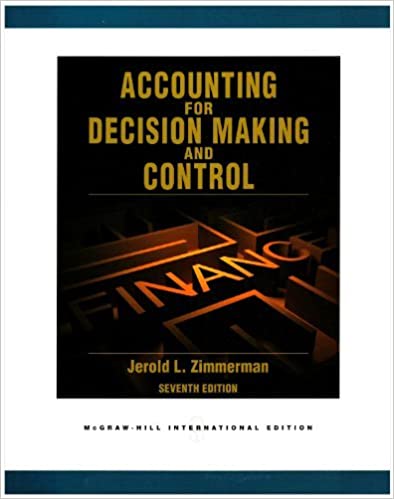
Accounting for Decision Making and Control 6th Edition by Jerold Zimmerman
Edition 6ISBN: 9780071283700
Accounting for Decision Making and Control 6th Edition by Jerold Zimmerman
Edition 6ISBN: 9780071283700 Exercise 5
Astin Car Stereos manufactures and distributes four different car stereos. The accompanying table summarizes the unit sales, selling prices, and manufacturing costs of each stereo.
ASTIN CAR STEREOS
Summary of operations Current Fiscal Year
 Selling and distribution (S D) expenses are $1,270,000. They are treated as a period cost and written off to the income statement. To assess the relative profitability of each product, S D expenses are allocated to each product based on sales revenue.
Selling and distribution (S D) expenses are $1,270,000. They are treated as a period cost and written off to the income statement. To assess the relative profitability of each product, S D expenses are allocated to each product based on sales revenue.
Upon further investigation of the S D expenses, half are shown to be for marketing and advertising. Each product has its own advertising and marketing budget, administered by one of four marketing managers. Z7, the premier product, is advertised heavily. Forty percent of the marketing and advertising budget goes toward Z7, 30 percent to B300, 20 percent to B200, and 10 percent to A90.
The remaining S D expenses consist of distribution and administration costs (25 percent) and selling costs (25 percent). The distribution and administration department is responsible for arranging shipping and for billing the customers. (Customers pay transportation charges directly to the common carrier.) It also handles federal licensing of the car radios. Upon analysis, each product line places equal demands on the distribution and administration department and each consumes about the same resources as the others. Selling costs consist primarily of commissions paid to independent salespeople. The commissions are based on gross margin on the product (sales revenue less manufacturing cost).
Required:
a. Allocate all S D expenses based only on sales revenue. Identify the most and least profitable products.
b. Allocate all S D expenses based only on the advertising and marketing budget. Identify the most and least profitable products.
c. Allocate all S D expenses. Use the advertising and marketing budget for advertising and marketing costs, the demand for these resources by product for distribution and administration costs, and commissions for selling costs. Identify the most and least profitable products.
d. Discuss the managerial implications of the various schemes. Why do the different schemes result in different product-line profits Which product is really the most profitable The least profitable
ASTIN CAR STEREOS
Summary of operations Current Fiscal Year
 Selling and distribution (S D) expenses are $1,270,000. They are treated as a period cost and written off to the income statement. To assess the relative profitability of each product, S D expenses are allocated to each product based on sales revenue.
Selling and distribution (S D) expenses are $1,270,000. They are treated as a period cost and written off to the income statement. To assess the relative profitability of each product, S D expenses are allocated to each product based on sales revenue.Upon further investigation of the S D expenses, half are shown to be for marketing and advertising. Each product has its own advertising and marketing budget, administered by one of four marketing managers. Z7, the premier product, is advertised heavily. Forty percent of the marketing and advertising budget goes toward Z7, 30 percent to B300, 20 percent to B200, and 10 percent to A90.
The remaining S D expenses consist of distribution and administration costs (25 percent) and selling costs (25 percent). The distribution and administration department is responsible for arranging shipping and for billing the customers. (Customers pay transportation charges directly to the common carrier.) It also handles federal licensing of the car radios. Upon analysis, each product line places equal demands on the distribution and administration department and each consumes about the same resources as the others. Selling costs consist primarily of commissions paid to independent salespeople. The commissions are based on gross margin on the product (sales revenue less manufacturing cost).
Required:
a. Allocate all S D expenses based only on sales revenue. Identify the most and least profitable products.
b. Allocate all S D expenses based only on the advertising and marketing budget. Identify the most and least profitable products.
c. Allocate all S D expenses. Use the advertising and marketing budget for advertising and marketing costs, the demand for these resources by product for distribution and administration costs, and commissions for selling costs. Identify the most and least profitable products.
d. Discuss the managerial implications of the various schemes. Why do the different schemes result in different product-line profits Which product is really the most profitable The least profitable
Explanation
Activity Based costing vs Traditional Co...
Accounting for Decision Making and Control 6th Edition by Jerold Zimmerman
Why don’t you like this exercise?
Other Minimum 8 character and maximum 255 character
Character 255


